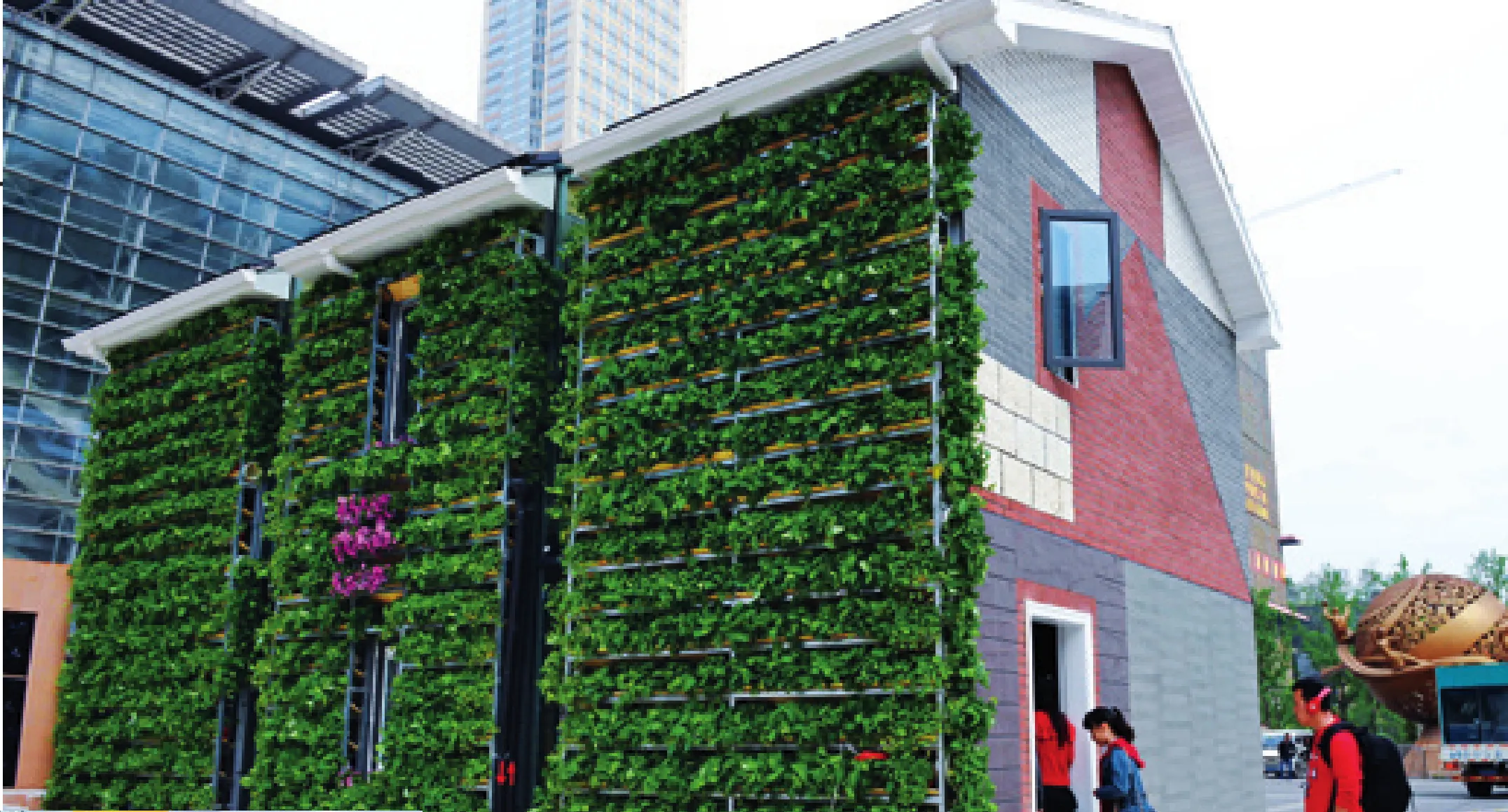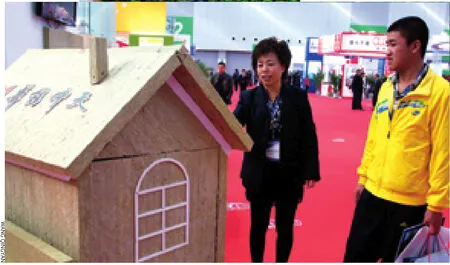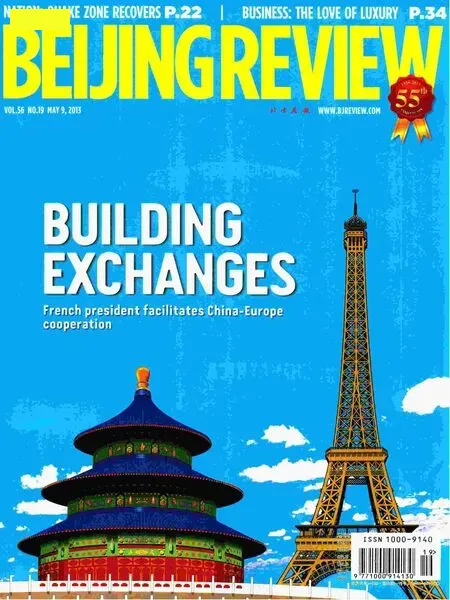A Greener future
Green buildings show promising prospects in China with new government incentives and public consciousness By Tang Yuankai
At the Sixth China International City Construction in Green and Low-carbon Expo in southwest China’s Chongqing from April 11 to 14, visitors were intrigued by three tiny “low-carbon houses,” two-story buildings covered on one side by lush green vegetation.
The floor space of each unit is only a bit more than 80 square meters. However, the structures erected for the expo adopted more than 60 low-carbon technologies to make them thoroughly green at heart.
More than 90 percent of the houses use the recyclable light steel structures and their frames are totally reusable, which can eliminate construction garbage. The roof-top gardens serve as the insulation layer for the house as well as increasing carbon sinks. Vegetables grown in the gardens can absorb carbon dioxide as well as satisfy food demand for people living in the houses. Instead of tap water, plants covering the houses rely on rainwater collected by a “smart” irrigation system, which reduces the houses’ carbon emissions through water reliance. Moreover, the houses also have photovoltaic panels installed on the roofs for electricity generation.
The walls around the living rooms are made of wheat straw fiberboard, which has minimal formeldehyde content. Moreover, the windows use self-cleaning glass. A coating of titanium dioxide gives the glass photo-catalytic properties,using sunlight to break down dirt particles for rainwater to effortlessly wash away any remaining residue.
Many visitors were amazed by the prospects of future homes. “The architectural creations by Chinese and British designers inspire people to think about the current human habitat system and will lead the trend for Chongqing’s green architecture,” said Wu Bo,an expert with the Chongqing Construction Technology Development Center.
Marcos Rosello, Director of All Design,a British firm that designs the “low-carbon houses,” said that design concepts are more important than the use of cutting-edge technologies or advanced materials.
“All the technologies applied in these buildings are mature technologies while no hitech materials were used. However, we used materials differently and applied proper guiding concepts, which ended up saving energy by more than 20 percent,” Rosello said. He also emphasized that all the construction materials are mass produced and most are made in China.
Figures from the expo’s organizing committee show that such a low-carbon house can recycle all the construction materials and water resources it consumed and satisfy no less than 30 percent of its energy needs with renewable energies.
Greener buildings
On January 1, the Chinese Government promulgated the Action Plan on Green Buildings,making the construction of green buildings a national strategy.
Following the document, the Ministry of Housing and Urban-Rural Development issued a development plan for green buildings and eco-friendly urban areas for the 12th Five-Year Plan (2011-15) period in April.


According to the 12th Five-Year Plan, China will achieve an urbanization rate of 51.5 percent by 2015. Such a goal mandates that new construction totaling 4 billion to 5 billion square meters will be built in urban areas within the same period. Both the scale and speed of the construction are unprecedented in the history of urban development. Now China’s annual construction area accounts for around half of the world’s total.
Meanwhile, China’s construction-related energy consumption accounts for 30 percent of the country’s total energy consumption and this figure has been growing every year. For a long time, China’s economy has been following an extensive growth mode, which has resulted in overuse of resources and environmental degradation. However, the new urbanization campaign offers a precious opportunity to transform this growth mode.
“The urbanization campaign will be guided by the concepts of green, low-carbon, livable cities and sustainable development, which will help the country to fu lfi ll its commitment to reducing its carbon dioxide emissions per 10,000 yuan ($1,618) of gross domestic product by 40 to 45 percent from 2005 levels by 2020,” said Li Xun, Secretary General of the Chinese Society for Urban Studies.
“China’s green buildings are at a phase of fast development and it is the right time to promote green buildings across the country,”said Wang Qingqin, Deputy Secretary General of the China Green Building Council and Assistant President of the China Academy of Building Research. He said that most technologies used in green buildings are mature, which will be perfected over the time and are ready for large-scale development of green buildings. “A system of detailed standards and regulations on green buildings is taking shape,” Wang said.
Wang said that the Central Government has always attached great importance to the development of green buildings and issued many documents on promoting green buildings. In May 2012, the Ministry of Finance and the Ministry of Housing and Urban-Rural Development jointly issued a list of subsidy standards for green building development in May 2012. Cert ifi ed two-star and three-star buildings will enjoy government subsidies of 45 yuan ($7)per square meter and 80 yuan ($13) per square meter respectively.
Green building certification agencies have been established in many provinces, autonomous regions and municipalities. Provinces such as Jiangsu and Anhui, as well as cities such as Wuhan in Hubei Province, Qingdao in Shandong Province, Shenzhen and Guangzhou in Guangdong Province and Xi’an in Shaanxi Province, have promulgated local policies to provide subsidies and other preferential treatment for the developers and purchasers of green buildings.
Meanwhile, standards and regulations on green buildings keep coming out, which regulate these buildings’ appraisal and design spec ifi cations. “The standards on green residential, industrial, educational, medical and retail properties either have been released or are being drafted,” said Wang.
China has also developed its own green building rating system, which is different from the Leadership in Energy and Environmental Design certification used in the United States and Building Research Establishment Environmental Assessment Method used in Britain.
Wang attributed the difference to disparities in culture and products between the countries.“But these systems are similar in their core values, such as conservation of energy, land,water and construction materials as well as environmental friendliness. Generally speaking,China’s green building rating system fi ts its own conditions,” Wang said.
New trends
Joe Van Belleghem is director of sustainable solutions at Lend Lease, a multinational property and infrastructure company based in Sydney,Australia. He said in Beijing recently that the focus of the global green construction market is shifting from the design of green buildings to the design of green communities, healthy complexes and new of fi ce areas.
According to Belleghem, there are two trends in the development of green buildings.The first is the stress on buildings’ overall effect on environment and sustainable designs.Instead of emphasizing materials employed in buildings, designers try to improve the overall protection of the environment while helping occupants to raise their quality of life, especially through bringing people living and working in city centers closer to nature.
The second trend, Belleghem said, is the newly gained emphasis on the greater context of improving quality of life for mankind besides conservation concepts.
Lend Lease entered the Chinese market 20 years ago. It recently signed a letter of intent with the China Energy Conservation and Environmental Protection Group, China’s leading company in energy conservation and environmental protection solutions. According to the document, the two companies will cooperate on developing green building complexes and low-carbon communities.
Compared with constructing new green buildings, many experts suggest that upgrading existing properties would be more effective in reducing China’s energy consumption at present.
“Energy ef fi ciency of existing architectures will be increased if their energy, water supply and garbage systems can be integrated,”said Nie Yaozhong, Lend Lease’s head of Development in China. He believes that casual decisions to abolish old buildings and build new ones on the same site are not viable for sustainable or low-carbon development.
At the Ninth International Conference on Green and Energy-efficient Building and New Technologies and Products Expo held in Beijing in April, Lend Lease hosted a forum on building carbon neutral cities in China.
At this forum, experts agreed that while carbon neutral cities represent the best model of sustainable urban development, green buildings lead the trend for modern architectural development. ■

